EVGA and NVIDIA To Split: EVGA Won’t Make Next-Gen NVIDIA Cards
by Ryan Smith on September 16, 2022 8:00 PM EST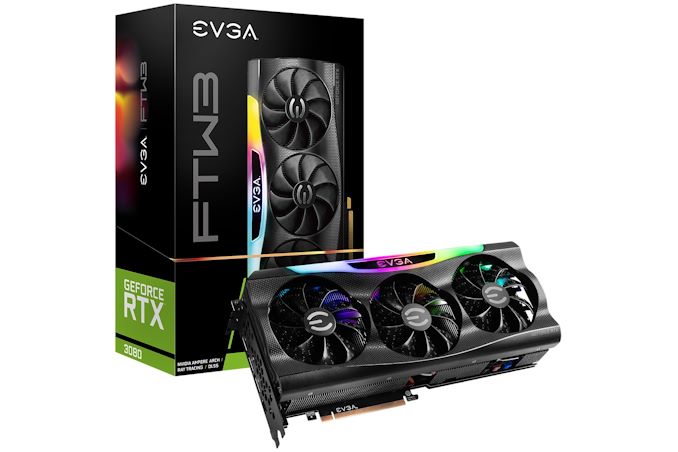
In a move that will have significant repercussions for the video card industry in North America and Europe, EVGA today has announced that the company is parting ways from NVIDIA. As a result, the company will not be producing video cards based on NVIDIA’s next-generation of GPUs – and won’t be immediately switching allegiance to AMD or Intel, either. Consequently, NVIDIA is losing their largest add-in board (AIB) in North America, and the broader North American video card market is losing one of its biggest and best-known vendors.
In a brief announcement posted on EVGA’s forums, the company outlined their parting from NVIDIA, while underscoring that this affects the next-generation of video cards, and that EVGA will continue to provide current-gen products and support existing customers.
- EVGA will not carry the next generation graphics cards.
- EVGA will continue to support the existing current generation products.
- EVGA will continue to provide the current generation products.
EVGA is committed to our customers and will continue to offer sales and support on the current lineup. Also, EVGA would like to say thank you to our great community for the many years of support and enthusiasm for EVGA graphics cards.
EVGA Management
Meanwhile, in a briefing attended by Jon Peddie Research and Gamers Nexus, EVGA’s CEO (and founder) Andrew Han laid out some further details about the transition. These are both great pieces and as I’m not going to simply rehash them point by point, I’d encourage readers looking for a first-hand recounting of the briefing to check them out.
As laid out in both pieces, EVGA’s parting from NVIDIA comes as the company’s relationship with NVIDIA has, according to EVGA, soured over the years. Most notably, AIB margins have been slowly shrinking over the past couple of decades, with JPR publishing that gross margins at the AIB partners have fallen from 25% in 2000 to 10% in 2015, and finally an estimated 5% this year. Meanwhile, as NVIDIA has slowly ramped up its own efforts to directly sell its Founders Edition (reference) video cards in Best Buy and other retailers, AIBs like EVGA have been put in a position of directly competing with their partner-turned-supplier.
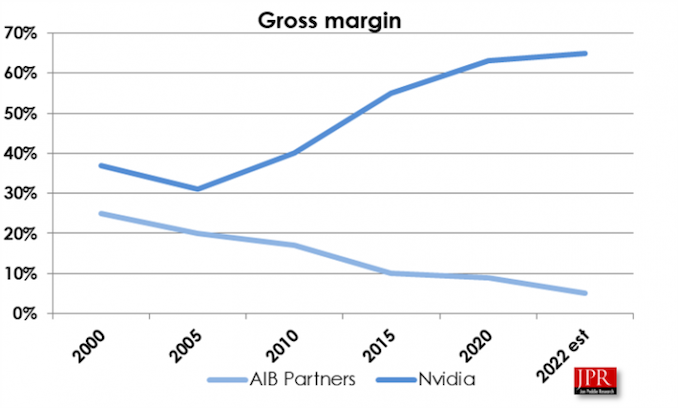
Jon Peddie Research: AIB Gross Margins v. NVIDIA Gross Margins
This, in turn, has put EVGA in a position where they are taking a loss on selling high-end NVIDIA cards, a significant shift from what are normally the highest margin products sold by video card vendors. And while consumers are benefitting from this in the short term via cheaper video cards, taking a loss of hundreds of dollars per video card is not sustainable – nor is it a viable business practice to begin with.
As a result of these factors (and undoubtedly more tales known only between EVGA and NVIDIA) EVGA has opted to part ways from NVIDIA. This means that EVGA will not be selling video cards based on NVIDIA’s next generation of GPUs, and that EVGA is ramping down production of existing GeForce RTX 30 series cards. According to Gamers Nexus, EVGA expects to run out of current-generation cards for retail by the end of the year, with the company setting aside a remainder of those cards as spares to honor warranty obligations.
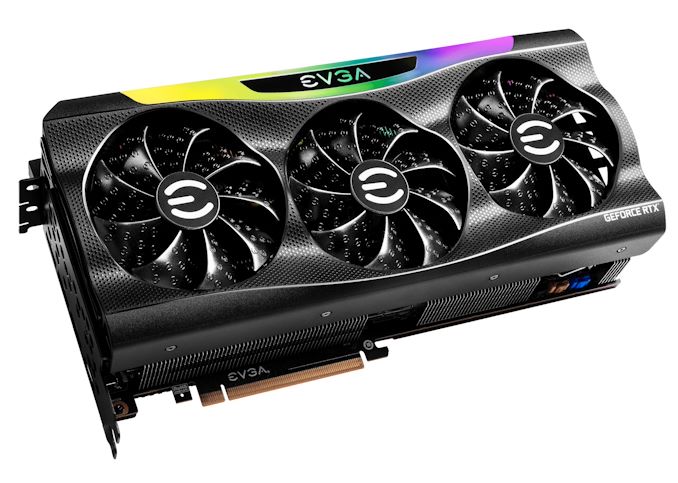
EVGA RTX 3090 Ti FTW3: A Money-Losing Product
Perhaps equally notable, EVGA has also made it clear that they are not immediately partnering with a competing GPU vendor, either. So for the moment, at least, this is not going to be a case of EVGA switching allegiances to AMD or Intel. Instead, EVGA is going to be out of the video card market for an indefinite period of time. To be sure, according to GN and JPR, the company has not completely closed the door on partnering with another GPU vendor, but they also aren’t actively pursing the matter right now.
And while this marks a massive cut to EVGA’s business – Gamers Nexus reports that video cards represent 80% of EVGA’s revenue – EVGA is not going out of business. The company still has a successful and well-regarded power supply business, as well as a more niche presence in high-end motherboards and gaming peripherals. This also means that EVGA will continue supporting its existing video card customers even once their remaining video card stockpile runs out, as the company still wants to maintain its sterling reputation for customer service.
Commentary: A Big Loss for Consumers, and a Opening the Door To Vertical Integration
EVGA’s exit from the video card industry represents what is easily the biggest shift in the retail video card landscape in over a decade. EVGA is not the first NVIDIA partner to part ways with the company – BFG and XFX were both major NVIDIA partners back in the 00s as well – but EVGA’s exit would seem to be the biggest yet. According to JPR, EVGA held 40% of the North American retail market, and they were a sizable player in Europe as well. EVGA was NVIDIA’s de facto premiere partner in the west, both in terms of total video card volumes and in terms of mindshare, with a legacy of producing high quality video cards backed with some of the best support in the industry.
As a result, EVGA’s exit is a big loss for consumers and video card enthusiasts overall. While NVIDIA can (and undoubtedly will) shift allocations over to their remaining AIB partners – Zotac is arguably the next best-known NVIDIA-exclusive vendor in North America – this still represents a reduction in competition in video card designs, especially with premium products where EVGA did some of their best work. And none of the remaining AIBs have a reputation for support that matches EVGA’s (though to be sure, reputation isn’t necessarily representative of the real world).
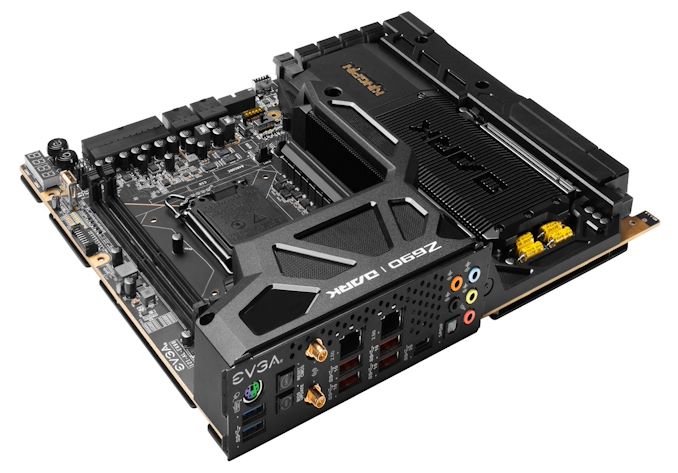
EVGA's Immediate Future: More Mobos and PSUs
But the full impact to the consumer market is going to hinge on what NVIDIA does next. From EVGA’s briefing it’s clear that there has been some friction between the two companies for quite some time, so while these revelations are new to outsiders, internally the businesses have been at odds for a while now. That means NVIDIA had plenty of time to prepare for EVGA’s split (they were first informed in April), and NVIDIA already has their own retail operations.
In fact, it’s those retail operations that seem to have led the way to what’s happening today. It wasn’t until the Pascal generation/GTX 10 series (2016) that NVIDIA began selling its own retail cards; for the 20 years before that, NVIDIA relied on AIBs to move its products. And even after that point, NVIDIA has purposely limited its reach by only selling cards directly, and later just through Best Buy.
Still, I’ve long wondered how AIBs have felt about NVIDIA going into competition with their own board partners, and now we have an answer, it would seem. EVGA is being driven out in part by NVIDIA’s direct presence on the market, with their Founders Edition cards undercutting EVGA’s products in price. It’s a relationship that by its very nature puts AIBs like EVGA at a disadvantage, as NVIDIA has the better brand recognition (all cards are NVIIDA cards) and much of NVIDIA’s R&D is paid for by their internal need for reference cards. This means that AIBs face additional costs on top of buying hardware from NVIDIA, especially if they want to go for premium designs like EVGA has been apt to do.
In short, NVIDIA’s decision to directly sell video cards, whether intentional or not, is putting the squeeze on AIBs. And NVIDIA-exclusive AIBs like EVGA are the most vulnerable.
EVGA’s exit from the video card market, in turn, opens the door to larger changes in video card manufacturing and distribution. Video card complexity has increased significantly over the years, and consequently so have the R&D costs at every single level. GPUs aren’t just getting more advanced, but they need ever finer PCB routing for memory, more advanced VRMs, bulked up cooling, and more. It’s not unlike the fab market, where every generation ups the ante on costs and discourages the kind of competition that results in lower prices, lower margins, and the inability to afford to play in the next generation of the game.
All of this, in turn, is making vertical integration look more and more appealing. While the AIBs in one form or another have played pivotal roles in the video card market since the dawn of the PC era, offering retail reach and support that the GPU vendors didn’t have or didn’t want to bother with, the actual value they add is, unfortunately, diminishing. Video cards are becoming so complex that, especially at the high end, the best move may very well be to stick with the reference designs. All of which further reduces the value (and uniqueness) AIBs can provide.
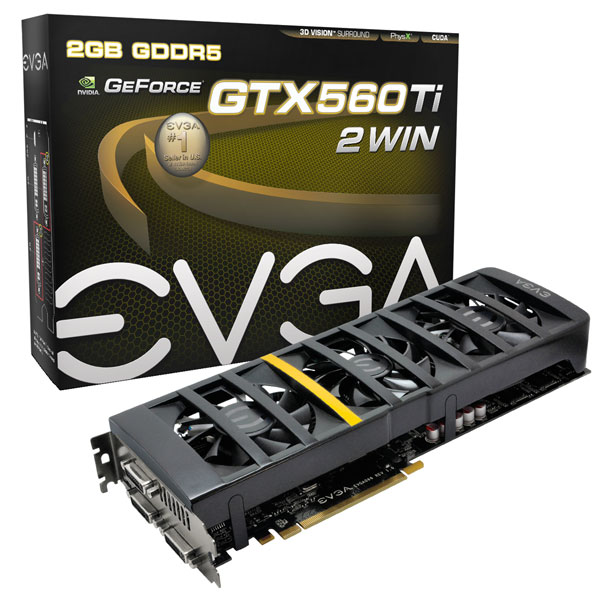
EVGA's Experiments Haven't Always Panned Out...
In short, this may be the moment where we see video card production pivot to having the GPU vendors themselves sell their cards, without the use of AIBs. So rather than having 10 video cards within a generation and then numerous AIB variations thereof – as is the case now with NVIDIA’s GeForce RTX 30 series – we’d have something more akin to desktop CPUs where there’s a dozen or so SKUs provided directly by the manufacturer.
Of course, this has been tried once before, with disastrous results (kids, go ask your parents about 3dfx), so it’s not by any means a sure-fire thing. But EVGA’s departure opens the door to NVIDIA to swoop in and take back 40% of their retail market for themselves, if that’s what they want.
And if NVIDIA doesn’t fill in the gap, then NVIDIA’s remaining AIBs will no doubt be happy to do it. The volume vacuum from EVGA’s exit means almost half the NVDIIA North American video card market is up for grabs. It is a huge opportunity to reshape that landscape and grab the kind of market share that would take years and years to peel away under more normal circumstances. So although a dark day for EVGA, opportunity knocks for the AIBs who remain.
The next-biggest question at this point is whether EVGA will remain in the video card market at all. From the Gamers Nexus and JPR articles it’s clear that EVGA is not keen on immediately jumping back in with a different partner. And, given that the Ethereum Merge just went through this week and video cards across the globe were liberated from their inane toiling (read: Ethereum is no longer relying on proof-of-work for blockchain processing), now is not the time to be making any firm plans.
The broad expectations of the industry are that all of these former mining cards are going to be boomeranging back on to the used video card market, similar to the last crypto hangover but in even larger volumes due to the much longer period this most recent mining boom went on. So the video card market is going to be dealing with an oversupply as it is, meaning that it’s not going to be a great time to be producing more video cards, as even next-gen cards below the flagship level will be competing with their predecessors.
So even if EVGA does ultimately opt to get back in to video cards – and I hope they do – sitting things out while the market corrects itself and digests the sudden surge of used cards is a prudent move. How long all of that will take remains to be seen, but as the current situation took years to get into, it won’t be a fast fix coming back out. In time, it would be a feather in either AMD or Intel’s cap to line up EVGA as a partner, as they bring a level of sophistication and respect that none of their current AIBs possess. Though it should be noted that the overall GPU market share is so significantly tilted in NVIDIA’s favor right now – a 4:1 ratio – that at former production levels EVGA could probably absorb most of the AMD retail market presence, something AMD’s other AIBs would no doubt be unhappy with.
Unfortunately, this exit also underscores how exposed EVGA is in the video card market, since video card sales were 80% of its revenue. The company has other product lines, but these are smaller in volume and all in product categories that are even more commoditized than video cards.

Over the Years EVGA Has Gone Big Into PSUs, In More Ways Than One
EVGA, for its part, has certainly made efforts to diversify over the years, but with limited success. Almost a decade ago I was fortunate enough to be at a business dinner with EVGA and Anand, where Andrew Han asked for our feedback on what sorts of products we thought would be good markets for EVGA to expand into. We ended up making several suggestions, but as today’s EVGA product mix shows, EVGA never found a second market on the same order of magnitude as video cards. Consequently, I’m not surprised to see Gamers Nexus report that EVGA is not planning on expanding into new product categories in the near future; that’s not something they’ve had luck with in better times, never mind going into this likely recession.
Ultimately, while today’s news marks a seismic shift in the video card landscape, it’s also the kind of news where there’s no way to put a positive spin on it. The video card market, for its part, will keep moving right along without EVGA, but the market and consumers are all the worse for EVGA’s departure. Thankfully, this is not EVGA’s eulogy – the company is still staying in business – but I sincerely hope that when we talk about EVGA in the future, it will be for more than just motherboards and PSUs. Video cards are were EVGA has made its name, and it’s still where EVGA does some of its best work.










119 Comments
View All Comments
Silver5urfer - Friday, September 16, 2022 - link
Excellent article, amazingly well rounded.Shame on how things are turning out, in GN piece we can see how Jensen treats AIBs and he wants to make Nvidia like Apple, a big greedy nasty corporation that yanks everyone (PowerVR, GT Technologies, Qcomm - they failed big since now A series relies on all Qcomm tech only). Not to mention how Vertical integration makes Apple the bidder of the products and they do it by giving contracts to cheaper alternatives - BOE display for instance in China was nothing but now ? even LG cannot face their LCD business which is actually rank #1, imagine LG corporation is facing heat due this crooked Apple. And Nvidia got kicked out by Apple as well but now since AMD has not much marketshare vs Nvidia the greed grows on and on.
Nvidia's policies are horrid to consumers too, they ruin their own HW like axing vBIOS modding by blocking firmware by Signature protection since Pascal. Before that Maxwell's GTX 970 3.5GB nonsense. Ampere's Power delivery failures on 3090 with Amazon's game, they purposefully design their products to be like this with a compromise to fail soon. Asking 2X price for 15% perf on 3080 -> 3090 was absurd. They raked profits in GDDR6X purpose built Ampere to mint mining. They killed the MXM program too for the DTR machines which was actually their own standard. On Linux side they provide garbage drivers as well just like Linus Torvalds says "F**k you Nvidia" an actual video exists too proving the malice of this corporation.
Ultimately this means a massive loss of American market consumers looking at sheer volume of EVGA in US and parts of EU, people have to deal with garbage RMA processing from ASUS, MSI, GB which are huge vs EVGA and also bad services and can take the heat from Nvidia.
But EVGA abandoning this big means they really know that new 40 series and up have severely high manufacturing costs and the profit cuts to Nvidia, plus the FE cards direct competition, even if EVGA tried to buy a lot of Ampere and tried more than they can chew ultimately the entire world finance effected by American Inflation at sky high 9-10%, massive Stock Market slump, poor GPU market and mining crash I can see why they want to take an exit. But do note that TiN left EVGA after Z390 series and the company took a long time to make Z590 out, their new 30 series designs had issues in the start with soldering too, they are losing their talent as we speak. Lucido / Kingpin is also leaving them now, I think there's a lot more parameters to this which is why Andrew Han is taking this approach.
The future is looking bleak to be honest and it's just sad. I hope he doesn't sell the IP and Brand and let it lose it's value, but also needs to think about AMD partnership, that may cause 7000 series skip but potential 8000 RDNA4 might help esp with all the experience of EVGA throwing it all away seems waste of ton of human resources, talent and also opportunities too esp offering consumers, us more choices.
Shame on this greedy Ngreedia corporation, Jensen even though he built a massive company but has not much of a moral code I mean this is a corporation but this is a specific market which is built on trust and mutual respect be it your customers / clients / partners. I really hope AMD can bust them and gain some marketshare and kick some sense into them.
I hate to see any regression in PC x86 space it's just bad.
RobATiOyP - Saturday, September 17, 2022 - link
Great commentary, was worth reading!Nvidia was forcing board partners to work with minimal info, they even had to beg the press to obtain gfx drivers.
s.yu - Saturday, September 17, 2022 - link
BOE is not where it is because of Apple though, it took a few right steps at the low end cutting LCD cost and easily grabbed the majority of the Chinese market, where it's easy for them to do business anyway, at the high end it stole some IP from the Koreans and put some pieces together, there was also some help from Beijing, and, maybe supplying *part of* the *lower end* of the Apple lineup made a difference of *some* significance.Dizoja86 - Saturday, September 17, 2022 - link
It would be interesting to see if AMD can finally catch up and release a modern card with features that match Nvidia's. They've been a generation behind for years now. Not that AMD has any more honour or ethics than Nvidia or Intel, but it's always amusing to watch big shitty corporations giving each other black eyes.RestChem - Sunday, September 18, 2022 - link
If they ever did, they'd disappear into obscurity, without that line nobody would have any reason to mention them anymore!Oxford Guy - Tuesday, September 20, 2022 - link
‘Jensen even though he built a massive company but has not much of a moral code’Corporations are only moral in the eyes of social Darwinists.
dalewilbanks - Saturday, September 17, 2022 - link
It's a sign of what's a happening: Graphics Card market has plateaued and will start falling down. My RTX3060 holds up just fine, even the laptop variant is decent. Why do I need to drop $400 on a new graphics card, which this 3060 will rock out for years to come? Nvidia is preparing for the worst.The Von Matrices - Saturday, September 17, 2022 - link
It's only falling down from an artificial high caused by ethereum mining and coronavirus lockdowns. The PCs with GPUs that are actually used for gaming will still continue to upgrade regularly.Shmee - Saturday, September 17, 2022 - link
I cannot stand idiots who think that AIB means partner company. It means add in board. Humanity sure can be stupid.Ryan Smith - Saturday, September 17, 2022 - link
When talking about the industry, AIB has long been shorthand for "Add-in board partner". It's a term that predates even me.